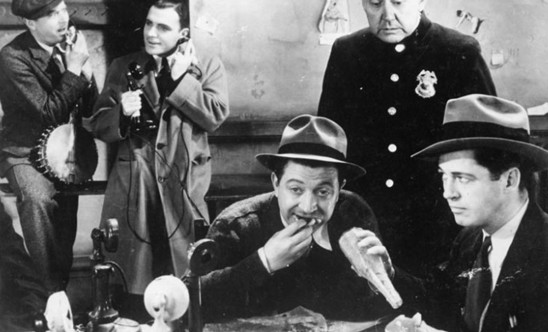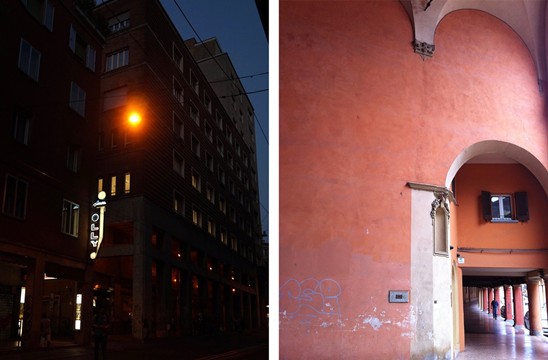
We’re really excited about our Archive Screening Day next Thursday 28th July at Watershed. Giving exhibitors the chance to see new restorations, hear from expert speakers from the world’s leading archives and learn from training sessions, it also offers a sneak preview of programmes from our upcoming tour of films from the BFI’s major new project, Britain on Film. It also kicks off another celebration of archive film in the form of Watershed’s inaugural Cinema Rediscovered. A new international film event, it’s inspired by what is still the biggest international archive film festival, Il Cinema Ritrovato in Bologna which every year attracts huge audiences to see beautifully restored work in glorious surroundings. In this piece Jo Comino, Marketing Manager for Borderlines Film Festival, reports on her 2016 trip to this wonderfully enjoyable festival.
A film festival worker myself, there was a whiff of predictability in my choice of summer holiday: five and a half days at Il Cinema Ritrovato in Bologna. Initiated four years ago into this fabulous film festival by friends who run the British Silent Film Festival, its now a fixture in my calendar. Go once and you’re hooked.
Il Cinema Ritrovato is literally a festival of rediscovered films, an occasion for archives from around the world to showcase their work. Its span is actually much wider that this would suggest. And there is nothing remotely fusty or dead about it. Over 8 days, from 25 June to 2 July, Il Cinema Ritrovato screened almost 500 titles, with dates ranging from the very beginnings of cinema in 1896 to the present day, the latter usually documentaries containing archive material like Letters from Baghdad (2016), on the explorer, archaeologist, Arab expert and WW1 British spy, Gertrude Bell.
With a weighty 100,000 attendances recorded in 2016, and 3,500 festival passes sold to delegates from over 50 countries, how come a festival whose content is made up of films from the past is so popular? OK, there are academics, archivists, filmmakers all over town but there are plenty of young people and students in evidence too. Several times – for a screening of a restoration of the 1931 version of The Front Page, for example, with its witty, hard-bitten cynicism and staccato dialogue – it was aisle-room only.

Imagine that all the films that as we, as regular cinema-goers, have access to are only the tip of an iceberg. A visit to this festival is the equivalent of plunging below the surface of the water and delving into what lies beneath – a perfect analogy but for the 30C plus temperatures in Bologna in late June. As Festival Director Gian Luca Farinelli writes in the beautifully-illustrated 393-page catalogue that arrives in your delegate bag: If you come to Il Cinema Ritrovato, it is because you want to experience depth and intensity.
There are six programme slots each day: two in the morning from 9am, perhaps an hour or so loophole to grab some lunch (remember, you’re in Bologna, the food capital of Italy) before the three afternoon shows, and another window for eating, drinking and comparing notes before the late evening screening just before 10pm. What complicates matters is that there’s the option of at least five films to watch at any one time and it’s not always easy to choose.
The festival is broken up into strands to help you make your own inroads into the programme. Loosely, there’s a Time Machine (films from the beginning of cinema in 1896, films from a hundred years ago), a Space Machine focusing on different national cinemas, this year from Argentina, Russia in the late Soviet era, Japan, Cuba and Iran) and The Cinephile’s Heaven (featuring restorations, spotlights on particular actors, directors, screenwriters and periods in cinema history).
Going down any one of these paths, and cutting across them, throws up pleasures, connections, discoveries. Quite randomly I chose two titles from the Alternate History of Argentinian Cinema, an opportunity to probe a national cinema beyond the classics and masterpieces that do reach us to ordinary movies that don’t, but which illuminate a particular time or sensibility.
Msall del olivido (Beyond Oblivion) (1955) was a black and white precursor of Vertigo, about a rich man who tries to re-mould a French prostitute in the image of his dead wife, set in the late 19th century and predominantly at night, full of Gothic flourish, but impressively taut and still at its core.
By contrast, Soar, soar (Dream, to Dream) (1975) had both the visual trappings and conventions of a seventies road movie except that the buddies are two losers – an opportunistic bearded and be-jeaned travelling showman and a naive country boy whom the showman hooks in by telling him he’s the spitting image of Charles Bronson and misadventure and pathos drive the narrative.

From Iran, in a collection programmed by London-based writer and curator Ehsan Khoshbakht from the independent Golestan Film Studio, active through the 1960 under the Shah’s rule, I was struck by the freshness of the New Wave Kheshto o Ayeneh (Brick and Mirror) (1963-4); black and white, widescreen, using direct sound and improvised dialogue. A taxi driver finds a baby abandoned in his cab and his dilemma makes for a parable that interweaves personal unease with social and political tension.
Equally striking were some of the short documentaries: Yekatash (A Fire) (1961) covering attempts to contain a massive oil well blaze and how it affects those living around it, and Khaneh Siah Ast (The House is Black) (1965) an unflinching and compassionate gaze into the heart of a leper colony by filmmaker/poet Forough Farrokhzad who died tragically young, aged 33.
The festival foregrounds the work of the Film Foundations World Cinema Project restorations and I was thrilled to discover among these a pair of documentaries, Raid into Tibet and Buddhism in Tibet (1966), directed by activist Adrian Cowell, that I’d only heard about through our own Festival Patron, the cinematographer Chris Menges. In 1966 Cowell, Menges and journalist George Patterson penetrated into Chinese-occupied Tibet with a small Khamba guerrilla force, sliding precariously down a 20,000-foot pass from northern Nepal, and captured the subsequent attack on a Chinese military convoy. Smuggled out of Nepal, the footage was aired on ATV before US and Chinese pressure put it out of circulation. The restoration, in association with the Tibet Film Archive, has enabled this rare and remarkable testimony of national resistance to come to light.

One of the most popular strands was the focus on feature films, specifically social and domestic dramas, from a brief period (1928 -1936) at Hollywood’s Universal Studios when Carl Laemmle Jr was head of production. Some films were more absorbing than others but, viewing them together, it was fascinating to pick up on recurring details, on ensemble actors, cinematic conventions and innovations and social history.
I loved the first double bill that pitted together two pre-Hays code films that dealt with the status of unmarried but attached women, both with John Boles as the male lead. Back Street (1932) is set in a 1890’s Cincinnati, populated by European immigrants, where the local hostelry is called Home on the Rhine and even the children nurse beer mugs. It stars the wonderfully sparky Irene Dunne as a young woman, who falls in love with a married financier and lives out her life (less sparkily) as his long-term mistress, an unofficial second wife.
Only Yesterday (1933) pre-dated Letter from an Unknown Woman, opening with a bold depiction of the Stock Market crash, complete with suicide, and sidestepping to a group of socialites gathering for a weekly cocktail party. Their host arrives, bankrupt and broken, to find a letter waiting for him from a woman (Margaret Sullavan) he has encountered more than once in his life but never fully recognised, whose existence has run parallel – possibly more meaningfully – to his own.

And there were connections to be made across strands. Towards the end of the festival I jumped from the male camaraderie of Jacques Becker’s Touchez pas au grisbi (1954) in which ageing bank robber Max (Jean Gabin) brings his equally elderly mate Riton to his hideout and offers him bedding, pyjamas and a midnight snack as they discuss how to safeguard the loot from their final big heist to Laughter in Hell (1933), a Universal picture with shades of O Brother Where Art Thou? in which Pat O’Brien endures and escapes from a chain gang run by his brutal arch-enemy to another prison breakout film, Le Trou (1960), also by Becker, riveting in its detail and subtle exploration of comradeship and betrayal.
A personal highlight was seeing again, after an interval of about thirty years, the restoration of Marco Bellocchio’s youthful tragi-comic masterpiece about madness, Ipugni in tasca (Fists in the Pocket) (1965) introduced by the director himself. Another restoration, Her Man (1930) with its superb titles drawn in the sand and washed by the tide, was a revelation. The teetering footsteps of washed-out, inebriated,deported Annie lead us back to a sleazy tropical capital and the Thalia bar where Frankie tries to throw off her sinister, stiletto-wielding pimp Johnnie for a loose-limbed, fresh-faced blond sailor called Dan whose striped T-shirt does definitely not survive the final bar-room brawl.
I fitted 33 films into my five-and-a-half days, hotfooting it down the arcades from the Cinema Arlecchino and the multi-salon Cinema Lumire to the Cinema Jolly, where the service in the cafe is so speedy that its always possible to grab a coffee with minutes to spare before the next screening.
The city embraces cinema; festival posters are everywhere and the free public outdoor screenings in the Piazza Maggiore are packed every night during the festival and throughout the summer, spilling into adjoining bars, and on to church steps. As the sounds of the prize fight in the closing film, John Huston’s Fat City (1972) rose to a crescendo, they were matched by resounding cheers and howls as Italy went into penalty shoot outs in the Euro 2016 quarter-final against Germany.

It’s impossible to talk about Il Cinema Ritrovato without mentioning its emphasis on colour: from the Technicolor section that included the screening of Martin Scorsese’s personal 35mm print of The Band Wagon (1953) to collections of early hand-tinted views, the first Konicolor and Fujicolor films from Japan, to the innovative and amazing Autochrome transparencies in the comprehensive Lumiere exhibition, receiving its first airing outside France in the underground exhibition space below the city’s main square.
In a city(Red Bologna) in which colour rules, from the earthy reds and ochres of the buildings, to the Campari or Aperol spritzes that kick off the evening, to the vivid fruit and veg in the indoor mercatodelle erbe, what could be more appropriate?

